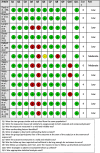Bridging the gap: A systematic review of intraoperative electrocochleography during cochlear implantation and preservation of residual hearing
- PMID: 40359384
- PMCID: PMC12074592
- DOI: 10.1371/journal.pone.0323493
Bridging the gap: A systematic review of intraoperative electrocochleography during cochlear implantation and preservation of residual hearing
Abstract
Cochlear implantation is a surgical intervention to provide auditory rehabilitation to individuals with severe to profound hearing loss. Intraoperative electrocochleography (ECochG) has emerged as a promising tool for monitoring cochlear health during cochlear implant (CI) surgery. This systematic review aims to synthesize current evidence regarding the effectiveness of intraoperative ECochG in predicting postoperative residual hearing levels in CI recipients. A comprehensive literature search was conducted across major databases including PubMed, Embase, Web of Science, and SCOPUS. The protocol for this systematic review was registered in the PROSPERO database (registration number: CRD42023476617). The key outcomes assessed were the correlation between intraoperative ECochG patterns and postoperative residual hearing levels, as well as the influence of surgical techniques and electrode design on ECochG responses and hearing preservation. The Risk of Bias analysis was conducted using the Joanna Briggs Institute Critical Appraisal Tool. The review included a total of eighteen studies that met the inclusion and exclusion criteria. A significant correlation was reported between specific intraoperative ECochG response patterns and the preservation of residual hearing post-surgery. Studies highlighted that robust ECochG responses typically indicated a higher likelihood of postoperative hearing preservation. The review also identified factors influencing ECochG responses, including electrode design and insertion techniques. Several studies reported improved preservation of residual hearing with modifications in surgical approaches guided by ECochG feedback. Intraoperative ECochG monitoring emerges as a crucial tool in predicting and potentially enhancing postoperative residual hearing outcomes in implanted individuals. The review underscores the value of ECochG in guiding surgical technique adjustments, thereby maximizing hearing preservation. However, the heterogeneity in study designs and ECochG protocols suggests a need for standardization in this field. Future research should focus on large-scale, multicenter trials to establish definitive guidelines for integrating ECochG in CI surgeries, with an emphasis on long-term hearing outcomes.
Copyright: © 2025 Cooper et al. This is an open access article distributed under the terms of the Creative Commons Attribution License, which permits unrestricted use, distribution, and reproduction in any medium, provided the original author and source are credited.
Conflict of interest statement
The authors have declared that no competing interests exist.
Figures






Similar articles
-
Intraoperative Intracochlear Electrocochleography and Residual Hearing Preservation Outcomes When Using Two Types of Slim Electrode Arrays in Cochlear Implantation.Otol Neurotol. 2019 Jun;40(5S Suppl 1):S29-S37. doi: 10.1097/MAO.0000000000002212. Otol Neurotol. 2019. PMID: 31225820 Clinical Trial.
-
Monitoring of the Inner Ear Function During and After Cochlear Implant Insertion Using Electrocochleography.Trends Hear. 2019 Jan-Dec;23:2331216519833567. doi: 10.1177/2331216519833567. Trends Hear. 2019. PMID: 30909815 Free PMC article.
-
Relationship Between Intraoperative Electrocochleography Responses and Immediate Postoperative Bone Conduction Thresholds in Cochlear Implantation.Otol Neurotol. 2022 Sep 1;43(8):e880-e887. doi: 10.1097/MAO.0000000000003620. Otol Neurotol. 2022. PMID: 35970166
-
Clinical Utility of Intraoperative Electrocochleography (ECochG) During Cochlear Implantation: A Systematic Review and Quantitative Analysis.Otol Neurotol. 2021 Mar 1;42(3):363-371. doi: 10.1097/MAO.0000000000002996. Otol Neurotol. 2021. PMID: 33347054
-
Correlation Between Electrocochleographic Changes During Surgery and Hearing Outcome in Cochlear Implant Recipients: A Case Report and Systematic Review of the Literature.Otol Neurotol. 2020 Mar;41(3):318-326. doi: 10.1097/MAO.0000000000002506. Otol Neurotol. 2020. PMID: 31834213
References
-
- Krogmann RJ, Al Khalili Y. Cochlear implants. StatPearls. Treasure Island (FL): StatPearls Publishing. Copyright © 2024, StatPearls Publishing LLC.; 2024.
-
- Boyd PJ. Potential benefits from cochlear implantation of children with unilateral hearing loss. Cochlear Implants Int. 2015;16(3):121–36. - PubMed
Publication types
MeSH terms
LinkOut - more resources
Full Text Sources
Miscellaneous

